
Welcome to ACHEMA 2022!
ACHEMA kicks off in just a few days. Here’s the lowdown on the essential information and top picks on what to see and do from The Medicine Maker team
Angus Stewart | | 14 min read | Review
You and ACHEMA probably need no introductions, so we’ll skip all pleasantries bar the essentials. First, the show opening and closing time.
From Monday August 22 to Thursday August 25, the show will be open 9am to 6pm all days. For the final day of the event on Friday August 26, the show doors will open at 9am and close at 4pm
Next, the public transport options. While in Frankfurt, do as the Frankfurters do. If you’ve got free time ahead and want to spend it on urban exploration (and you should!) then your options are the S Bahn (S for stadt “city”), the U Bahn (U for untergrund “underground”), and also the city’s tram and bus networks. Many stations are hubs for several services, as demonstrated in the two big transit candidates for ACHEMA attendees.
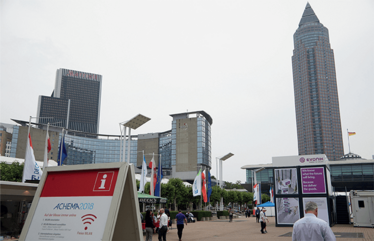
Image Credit : Copyright: Dechema e.V / Jean-Luc Valentin
Festhalle/Messe U Bahn station
Festhalle/Messe is a great little hub, sitting on the western arm of the (roughly) U-shaped Line 4. Departing south from Festhalle/Messe will curve you north again through Hauptbahnhof (central station), then send you northwest. Two stops after Hauptbahnhof, Line 4 hits another major interchange at Willy-Brandt Platz. Festhalle/Messe station also hosts two tram lines – 16 and 17 – which both lead north to West-bahnhof, and south across the River Main to the hub station Stressemanallee/Gartenstrasse. Line 16 riders can stay on here all the way to mega-hub Südbahnhof and beyond. Last – and least, in the eyes of trainspotters – Festhalle/Messe is also a stop for four of Frankfurt’s bus routes: the 50, the M46, the N16, and the N4.
Messe S Bahn station
The slash in the name of the aforementioned U Bahn station is a blessing because it helps differentiate it from this S Bahn station that lies on the western side of the venue. Generally speaking, Germany’s S Bahn lines sit somewhere on a spectrum between urban commuter and regional lines. In Frankfurt, the S Bahn can get you around and out of the city, though for central destinations the U Bahn is a better bet. That said, Hauptbahnhof lies just two S Bahn stops to the south, and from there riding the S Bahn further south still, across the Main, gets you to the airport schnellschlau (quicksmart)!
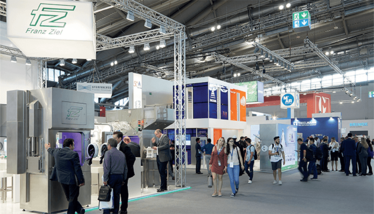
Image Credit : Copyright: Dechema e.V / Jean-Luc Valentin
ACHEMA’s story
ACHEMA is a big deal. (Of course it is – you’re prepared to travel to spend time with it.) But just how well do you know the show’s background?
ACHEMA’s founder, Max Buchner, dreamed up the exhibition in 1918. He wanted to create a cooperative meeting place for chemistry and engineering, which at that time remained two separate worlds. His grand idea arrived right after the defeat of the German Empire in World War I, and its realization came in 1920 at the dawn of the Weimar Republic – a new, open, and exciting German democracy. ACHEMA kept running through the Weimar period. 1926 saw the setup of a parent company named DECHEMA, and ACHEMA’s sixth iteration in 1930 attracted the event’s first international attendees. ACHEMA continued to run after Hitler took power in 1933, but was dealt a blow when the DECHEMA Frankfurt headquarters were destroyed in 1944 – a year of multiple allied bombing raids on the city. The next year, the US 5th infantry and 6th armored division showed up and captured the city in four days.
The first postwar ACHEMA was held in Festhalle in 1950. Here, we would direct readers to the ACHEMA website where they can enjoy a few hip and/or groovy photographs of the event and its attendees in the first postwar decades. In the shot for 1973, we see three ladies dressed in styles very much of the decade, surveying some equipment. The ACHEMA site captions the photo “Diversity,” and notes that the women in the photograph won’t be limiting themselves to the “ladies program.” We’ve come a long way, haven’t we?
The late seventies and eighties saw some interesting ACHEMA traditions spring up: “India day,” and the opening of the event by a live orchestra playing the overture to Wagner’s The Master-Singers of Nuremberg.
Speaking of both coming a long way and events of epic Wagnerian import, ACHEMA did take a minor hit at the hands of COVID-19. The event is tri-yearly, but its last iteration was held in 2018. Although a digital ACHEMA did happen in 2021, it only pulled in a fraction of its usual attendee and exhibitor turnout.
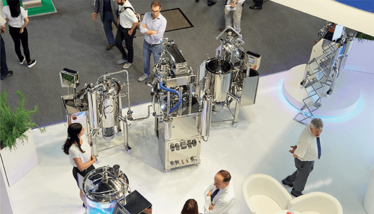
Image Credit : Copyright: Dechema e.V / Jean-Luc Valentin
Events of the day: our picks
ACHEMA attendees like you have no excuse for idleness. The schedule combines the trade show with the ACHEMA congress. If drawing up your own personal timetable seems a task of Herculean proportions, then fear not. For each day, we’ve picked two special recommendations from the ACHEMA Congress program for your consideration spanning core pharma topics as well as a few outliers from other industries that could prove fascinating.
Monday 22
ACHEMA’s Theme of the Day: Hydrogen Economy
How additive manufactured parts enable optimization of chemical processes
15:15 – 15:45, Hall 11.0
Daniel Urbanczyk and two colleagues from BASF discuss the work behind their company’s new additive manufacturing center. They will give examples from various cases to show how they optimized the processes involved.
C2PAT - Carbon To Product Austria
16:15 – 16:45, Hall 9.1
In Project C2PAT, a number of Austrian companies worked to reduce their large carbon dioxide footprints. Here, various figures involved will present their plans for a renewable plastics production site.
Tuesday 23
ACHEMA’s Theme of the Day: Fossil-Free Production
Substance elimination in the pharmaceutical industry
11:00 – 11:15, Hall 9.1
In Germany and around the world, we’re waking up to the problem of pharmaceutical pollutants in our water. Here, scientists discuss how to both detect and reduce the pollution.
#empowerthefield – use the potential of industry 4.0
10:30 – 10:50, Hall 11.0
Representatives from Endress+Hauser discuss how their company aims to unlock the 97 percent of industrial process sensor data that goes unused. Are online tools and apps up to the task?
Wed 24
ACHEMA’s Theme of the Day: Perspectives in Laboratory and Analytics
Continuous crystallization of active pharmaceutical ingredients.
11:50 – 12:10, Hall 4.C
Academics from Katholieke Universiteit Leuven talk crystallization – a major bottleneck in continuous manufacturing. In this presentation, they run through what it will take to solve the problem.
Modular plants in the context of decentralized production networks: Bio-based products with reduced CO2 footprint
16:15 – 16:45, Hall 9.1
Fossil fuels will run out one day, and that’s why these speakers want to talk “renewable feedstock” – biofuels. Their argument here is that a decentralized European network for growing/producing these fuels will help mitigate the uncertainty of their supply and demand.
Thursday 25
ACHEMA’s Theme of the Day: Digitalization in the Process Industry
What is more important to enable efficient cyber-physical systems – Digital Twins or the degree of automation in RnD labs?
10.30 – 10:50, Hall 11.0
Everyone loves a good dilemma. Rolf Gueller is the only speaker here, and will be making the case for both digital twins and automation in research and development. Show up and see if he picks a winner.
Using 3rd Gen AI Methods and More to Achieve Higher Sustainability in Process Manufacturing
16:15 – 16:45, Hall 11.0
It’s not easy to come by a simple, universal definition of “3rd gen AI,” but perhaps you’ll find one here as Symphony Industrial AI CEO Dominic Gallello describes how digital twins can take plant operations and manufacturing to the next level.
Friday 26
ACHEMA’s Theme of the Day: Novel Bioprocesses and Technologies
Case Study: Introduction of a New Highly Potent Biopharmaceutical Product into an Existing Facility
13.15 – 13:45, Hall 3.0
Morcos Loka of Egyptian company Minapharm recounts how his company brought a new HPAPI into their fill & finish sterile production facility. The mission was to identify risks and define necessary controls, and Loka will take you through it all step-by-step.
Model assisted Design Strategies for Bioprocesses – Transfer from Academia to Industry
11:45 – 12:15, Hall 4.0
Here, speakers from the Hochschule Furtwangen and Hamburg universities propose that industry make more and better use of mathematical models commonly used in academia. They believe these can help in bioprocessing development and design strategies.
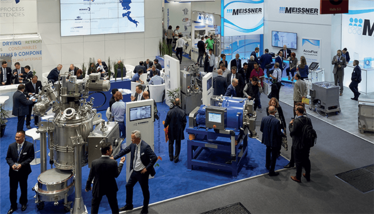
Image Credit : Copyright: Dechema e.V./Jean-Luc Valentin
Festhalle: a short history
At the time of its opening in 1909 by Kaiser Wilhelm II, Festhalle was the largest dome in Europe. It hosted various leisure, sporting, and business events until the outbreak of World War I, when it was promptly taken over by the military to be used as a barracks. After the war, it became a venue once again until the 1930s.
The Nazi Party made frequent use of Festhalle for propaganda rallies, and 1938 saw the venue put to darker use still when hundreds of Frankfurt’s Jewish citizens were herded into the venue during Kristallnacht. It was from here that the first mass transports to concentration camps began. A plaque inside Festhalle’s rotunda stands to remind visitors of this sad fact. After World War II broke out, Festhalle was claimed by the military again, but this time only to store uniforms and ammunition. A fire struck the building in 1940, and later on Allied bombing worsened the damage, reducing Festhalle to nothing but walls and an iron structure.
After the war there was debate over whether to rebuild or bulldoze Festhalle, but thanks to the efforts of the citizens and town mayor, “rebuild” won out. The straight-laced 1950s and early 60s saw the venue host trade fairs, motor shows, and conventions for clubs and the political parties of West German democracy. When the hippy revolution washed over Europe, Festalle got cool; 1970 saw Led Zeppelin become the first rock band to headline the venue, and across the years and decades since Festhalle has racked up quite a list of alumni: the Rolling Stones, Pink Floyd, Red Hot Chili Peppers, Westlife, David Guetta, and Billie Eilish, to name but a few.
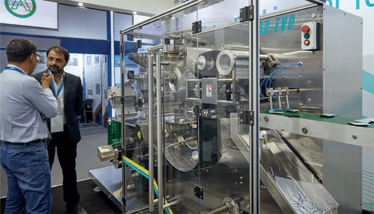
Image Credit : Copyright: Dechema e.V./Jean-Luc Valentin
ACHEMA 2022: Scattered Factoids
- Minimum stand height this year is 2.5 meters, and max is 8
- As it stands, 27 industry societies are officially associated with ACHEMA
- ACHEMA launched a print and digital magazine called ACHEMA Inspire in 2021. It produced two issues in that year, and thus far has put out one in 2022
ACHEMA 2018: the headcount
- 144,628 attendees from 150 countries:
- 107,659 industry visitors
- 28,494 booth personnel
- 7,980 university & school students, teachers, and apprentices
- 495 journalists
- The 3,737 exhibiting companies hailed from 55 countries
- 56% of attendees were from outside Germany
- On average, attendees stayed for 1.9 days
- Attendees by profession:
- 40.3% – Engineer
- 13.6% – Foreman, technician, laboratory assistant
- 12.9% – Other jobs
- 12.7% – Chemist, physicist
- 12.0% – In training
- 8.6% – Commercial professions
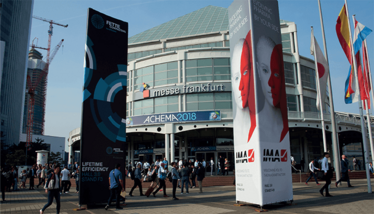
Image Credit : Copyright: Dechema e.V. / Helnut Stettin
A Guide to Frankfurt
Ever shown up for a conference, stepped out of the airport doors, and thought where am I? It’s okay – your feelings are valid. You may well know nothing about Frankfurt beyond the famous sausage, but I’m just a website – I’m not here to judge you. In fact, I’m here to help you.
First of all, let’s meet Frank. The “Frank” part in “Frankfurt” comes from the Franks, a Germanic tribe who also ended up lending their name to a certain European country: France. “Furt” translates to “ford” and historians reckon we have “Frank-furt” (the ford of the Franks) due to a moment in history when the Franks drove the Alemanni – another German tribe – south. This was during the 6th century, and in a newly post-Roman Europe defined by fierce competition between these Germanic tribes, the Franks were among the first to form a large, stable kingdom. FUN FACT: the parent company behind this very website is based in Knutsford, a town which – as you may well guess – also takes the latter half of its name from a “furt”.
Famous faces
The Big Names
- Hans Zimmer. He’s the biggest living name in cinematic soundtracks, famous alone and as a regular collaborator with Hollywood titans such as Ridley Scott and Christopher Nolan. Like our next big name, Zimmer is Jewish; his mother survived the Nazis and the war by fleeing to England, then returning.
- Anne Frank. Included in this list for more tragic reasons, Anne Frank and her diary are marked indelibly on Western collective consciousness. She was born in Frankfurt, but at the age of four left with her family for Amsterdam following the Nazis’ seizure of power.
The Big Money
- J Cole. Most of the world knows Jermaine Lamarr Cole as an American rap superstar. He was born to a German mother in a US military base in Frankfurt. His father was an African-American soldier on the base. At only eight months old, his mother brought him back to the states.
- Peter Thiel. Another US emigre, Thiel is a PayPal co-founder, a right/libertarian megadonor, and an investor in life extension, cryptocurrency, and “seasteading.” Search his name and you’ll fall down a platinum-tier internet rabbithole. Seriously though, Google “seasteading.” It is truly bizarre.
The Big Minds
- Goethe. The undisputed king of German lit. Ever made a “Faustian bargain”? You owe a debt to Goethe. Ever wondered who coined “world literature”? That was Goethe, in the early 1800s. He was born in Frankfurt, and today you can visit the elegant family home he grew up in.
- Adorno. Philosopher-king of the influential Frankfurt school. His critical essays on politics, literature, and mass culture are a staple of humanities departments worldwide. At Theodor W Adorno Platz on the Goethe(!) University campus, his desk sits preserved inside a glass case. Sehr provokativ!
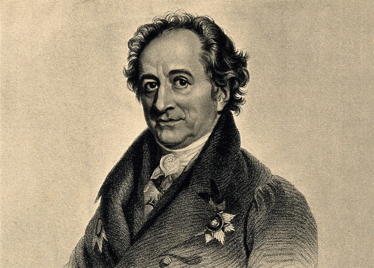
Goethe, Frankfurt literati | Image Credit : Wellcome Trust / commons.wikimedia.org
Curious sights
- Goldkammer: a hypermodern museum dedicated to golden objects. There are 500 artefacts, spanning 6000 years, presented in a beautiful 19th century villa in Frankfurt’s historical West End district. It even has a restaurant attached (but be aware that it’s reassuringly expensive).
- Dialog Museum: a social enterprise/museum where visually impaired experts guide visitors through themed rooms, all in pitch darkness. In their own words, “Empathy is not a nice to have. It’s a must have.” Tours last last 60 minutes and end in a “dark bar.” To take the tour you’ll need a group (but you won’t need a torch).
- “Crashed train” subway entrance: the Bockenheimer Warte U Bahn entrance is designed to resemble an old-fashioned tram carriage that has sunk into – or is emerging from – the earth. It has been in place since 1986.
- The Pinkelbaum: “Pinkelbaum” means peeing tree, and the name tells no lie. Artist Friedrich Karl Waechter is the likely penman behind a nearby plaque which reads, “For 300 years, I was pissed at, starting today I piss back.” To visit this cheeky tree, ride tramline 17 directly from Festhalle south into Frankfurt’s urban forest.
- The Paternoster Elevator: this is one of the last elevators of its kind. Located in Fleming’s Hotel in Bleichstrasse, this lift is built from two doorless elevator boxes that cycle continuously around two shafts. Sounds a little unsafe? Fortunately the 1952 model here has special safety mechanisms in place. The hotel is nice too!
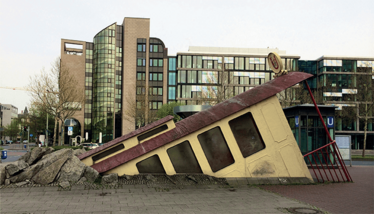
Image credit : Kiefer / flickr.com | Image description : Bockenheimer Warte
Eat and drink
- Apfelwein. This ciderlike beverage is a Frankfurt staple with a story attached. In the 1800s, a certain Frau Rauscher made a name for herself by compulsively stealing and draining strangers’ glasses. Now, a (water-)spitting statue commemorates her. Try some apfelwein at Ebbelwoi Unser, a rustic German tavern.
- East Asian options. For pulled-noodles dry or soupy, try the Lanzhou-style Chinese fare at The Noodlemaker or Ramen Jun for the nourishing Japanese equivalent. For cosy Korean comfort food there’s Misho. And if you fancy a drink after all that then seek out Shuka Bar, a secret sake and whisky joint.
- German cuisine. For the Bavarian experience, feast on schnitzel and lagerbier at Paulaner am Dom – a chain owned by the big name brewer. We also recommend Pauline im Europagarten. It’s a quirky building in an urban park, and serves hearty German fare amidst modern decor.
- Bizarre bars. Maybe you need a post-ACHEMA drink. (Nobody blames you.) Here are three suggestions: i) Logenhaus lets you sip gin amid gorgeous ‘20/30s decor; ii) Hunky Dory Bar has ‘30/40s flea market treasures instead, plus you can order drinks by dialling on a rotary phone; iii) Normalkneipe is a simple traditional pub serving a wide range of craft beers.
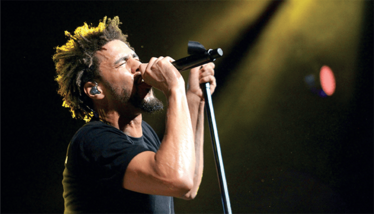
J Cole, American rapper born in Frankfurt | Image Credit : pxhere.com
Between studying for my English undergrad and Publishing master's degrees I was out in Shanghai, teaching, learning, and getting extremely lost. Now I'm expanding my mind down a rather different rabbit hole: the pharmaceutical industry. Outside of this job I read mountains of fiction and philosophy, and I must say, it's very hard to tell who's sharper: the literati, or the medicine makers.



















